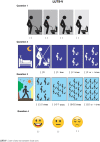Luts-V: A new simplified score for assessing lower urinary tract symptoms in men
- PMID: 33620997
- PMCID: PMC7993949
- DOI: 10.1590/S1677-5538.IBJU.2020.0278
Luts-V: A new simplified score for assessing lower urinary tract symptoms in men
Abstract
Objectives: Develop and validate a new and simplified score for evaluating the lower urinary tract symptoms in men.
Materials and methods: We modified the existing visual prostate symptom score, including changes in the images, sequence, and new alternatives, resulting in a new visual score (LUTS visual score-LUTS-V). For the validation of the new tool, we used the International Prostatic Symptom Score as the gold-standard and the new LUTS-V to 306 men. The total IPSS score and the total LUTS-V score of each subject were evaluated to determine the agreement between the two instruments. ROC curve was used to evaluate the diagnostic accuracy and best cut-off of LUTS-V. Sensitivity, specificity, and diagnostic odds ratios were used to describe the diagnostic properties.
Results: The mean age of the participants was 59 [52-87] years. There was a significant correlation between LUTS-V and IPSS. (r=0.72 (p<0.0001). The Bland-Altman analyzes demonstrate good agreement between the two questionnaires (bias=5.6%). LUTS-V demonstrated excellent diagnostic accuracy in detecting the most serious cases with an area under the ROC curve of 83% [78-87%] 95% CI. p <0.001). LUTS-V >4 was the best threshold, with a sensitivity of 74% and specificity of 78%.
Conclusions: LUTS-V is a simple, self-administered tool with a significant discriminatory power to identify subjects with moderate to severe LUTS and may represent a useful instrument for the diagnosis and follow-up of men with urinary symptoms.
Keywords: Men; Prostate; Validation Study [Publication Type].
Copyright® by the International Brazilian Journal of Urology.
Conflict of interest statement
None declared.
Figures



Comment in
-
Editorial Comment: Luts-V: A new simplified score for assessing lower urinary tract symptoms in men.Int Braz J Urol. 2021 May-Jun;47(3):533-534. doi: 10.1590/S1677-5538.IBJU.2020.0278.1. Int Braz J Urol. 2021. PMID: 33620998 Free PMC article. No abstract available.
Similar articles
-
The visual prostate symptom score is a simple tool to identify and follow up in general practice patients with lower urinary tract symptoms associated with benign prostatic hyperplasia (a study with 1359 patients).Presse Med. 2018 Jul-Aug;47(7-8 Pt 1):e91-e98. doi: 10.1016/j.lpm.2018.06.011. Epub 2018 Jul 31. Presse Med. 2018. PMID: 30075950
-
Severity of lower urinary tract symptoms reflects different composition of bladder storage dysfunction and bladder outlet obstruction in men with symptomatic benign prostatic hyperplasia.Int J Clin Pract. 2014 Jun;68(6):743-8. doi: 10.1111/ijcp.12364. Epub 2014 Jan 29. Int J Clin Pract. 2014. PMID: 24471413
-
Assessment of lower urinary tract symptoms in men by international prostate symptom score and core lower urinary tract symptom score.BJU Int. 2012 May;109(10):1512-6. doi: 10.1111/j.1464-410X.2011.10445.x. Epub 2011 Aug 26. BJU Int. 2012. PMID: 21883834
-
EAU Guidelines on the Assessment of Non-neurogenic Male Lower Urinary Tract Symptoms including Benign Prostatic Obstruction.Eur Urol. 2015 Jun;67(6):1099-1109. doi: 10.1016/j.eururo.2014.12.038. Epub 2015 Jan 19. Eur Urol. 2015. PMID: 25613154 Review.
-
Phosphodiesterase inhibitors for lower urinary tract symptoms consistent with benign prostatic hyperplasia.BJU Int. 2019 Jul;124(1):27-34. doi: 10.1111/bju.14689. Epub 2019 Mar 11. BJU Int. 2019. PMID: 30681264
Cited by
-
Editorial Comment: Luts-V: A new simplified score for assessing lower urinary tract symptoms in men.Int Braz J Urol. 2021 May-Jun;47(3):533-534. doi: 10.1590/S1677-5538.IBJU.2020.0278.1. Int Braz J Urol. 2021. PMID: 33620998 Free PMC article. No abstract available.
-
How Do Patients Understand Questions about Lower Urinary Tract Symptoms? A Qualitative Study of Problems in Completing Urological Questionnaires.Int J Environ Res Public Health. 2022 Aug 5;19(15):9650. doi: 10.3390/ijerph19159650. Int J Environ Res Public Health. 2022. PMID: 35955002 Free PMC article.
-
Mobile health may improve evaluation of lower urinary tract symptoms.Int Braz J Urol. 2021 Nov-Dec;47(6):1195-1197. doi: 10.1590/S1677-5538.IBJU.2021.06.01. Int Braz J Urol. 2021. PMID: 34469671 Free PMC article. No abstract available.
References
-
- 1. Irwin DE, Milsom I, Hunskaar S, Reilly K, Kopp Z, Herschorn S, et at. Population-based survey of urinary incontinence, overactive bladder, and other lower urinary tract symptoms in five countries: results of the EPIC study. Eur Urol. 2006; 50:1306-14. - PubMed
-
- 2. Soler R, Gomes CM, Averbeck MA, Koyama M. The prevalence of lower urinary tract symptoms (LUTS) in Brazil: Results from the epidemiology of LUTS (Brazil LUTS) study. Neurourol Urodyn. 2018; 37:1356-64. - PubMed
-
- 4. Reggio E, de Bessa J Jr, Junqueira RG, Timm O Jr, Sette MJ, Sansana V, et al. Correlation between lower urinary tract symptoms and erectile dysfunction in men presenting for prostate cancer screening. Int J Impot Res. 2007; 19:492-5. - PubMed
-
- 5. Coyne KS, Wein AJ, Tubaro A, Sexton CC, Thompson CL, Kopp ZS, et at. The burden of lower urinary tract symptoms: evaluating the effect of LUTS on health-related quality of life, anxiety and depression: EpiLUTS. BJU Int. 2009; 103 (Suppl 3):4-11. - PubMed
MeSH terms
LinkOut - more resources
Full Text Sources
Other Literature Sources
Medical
